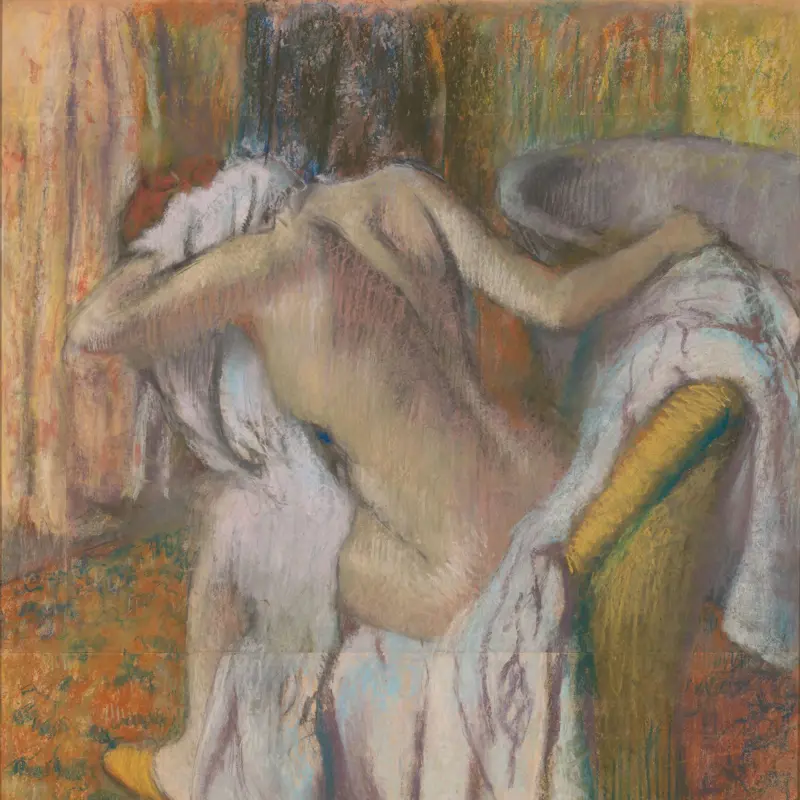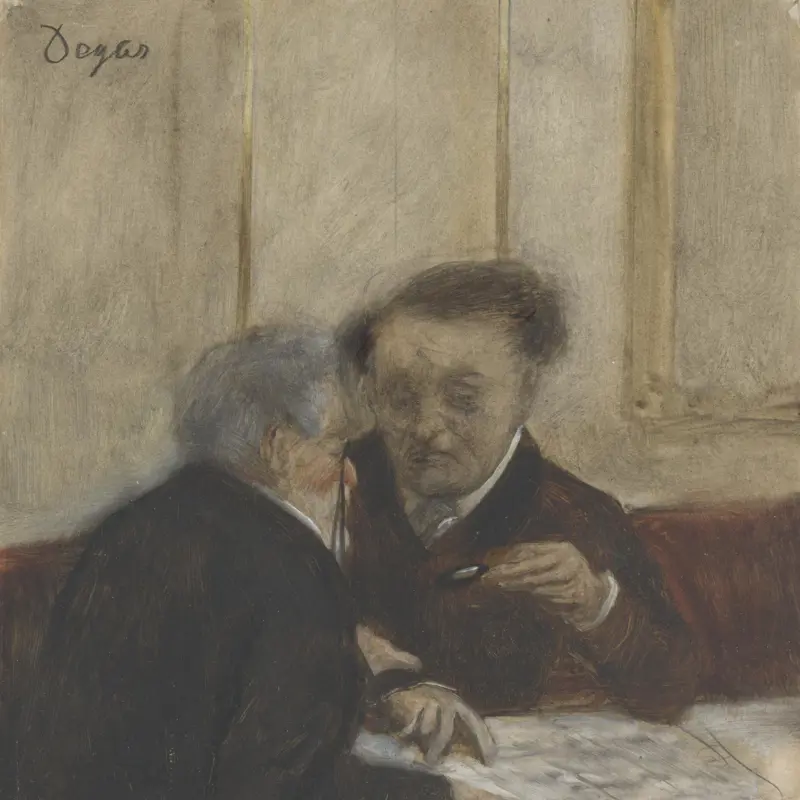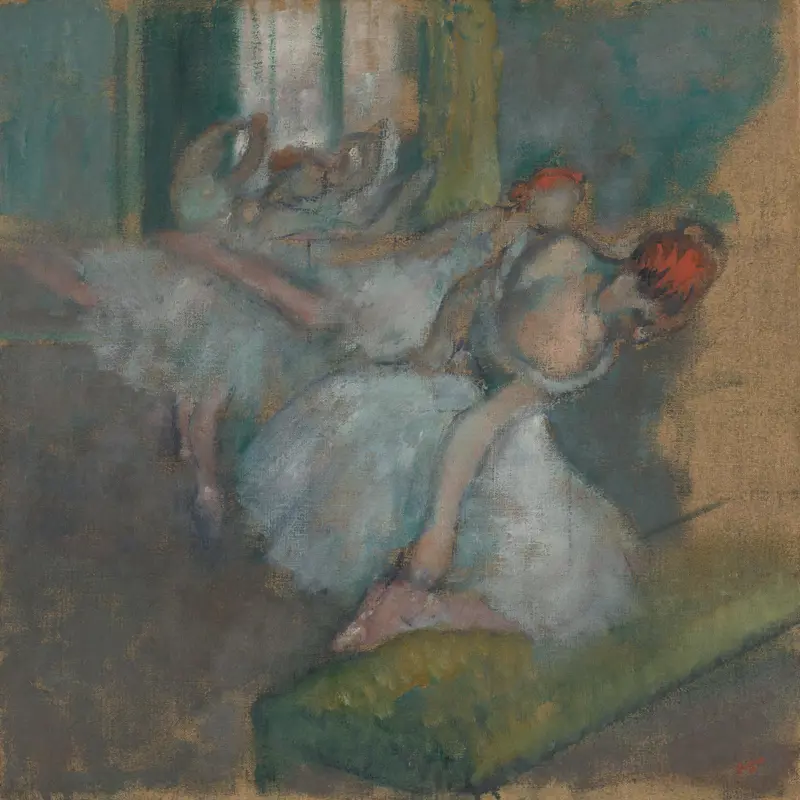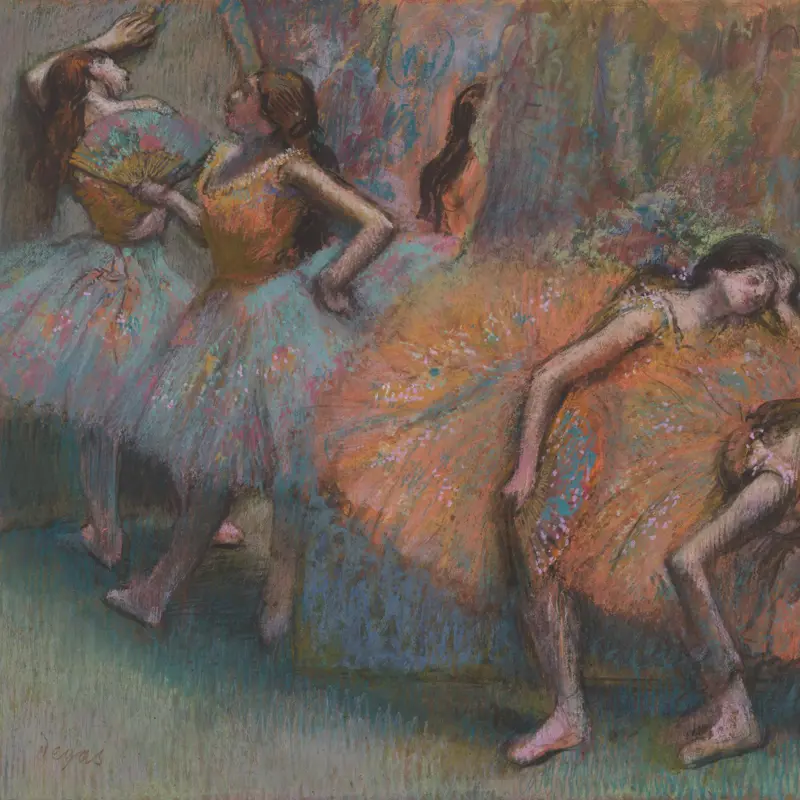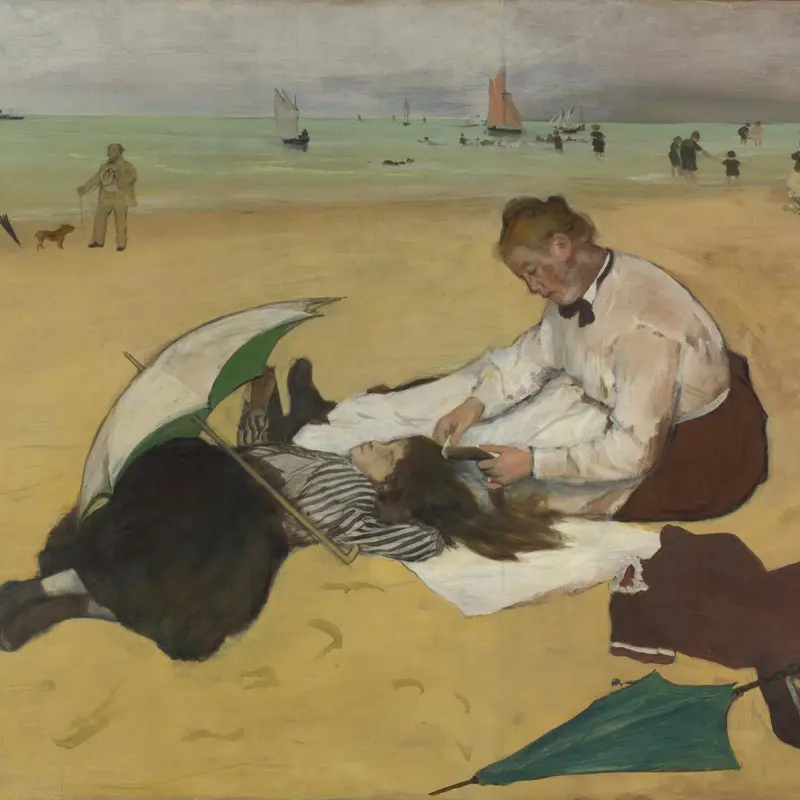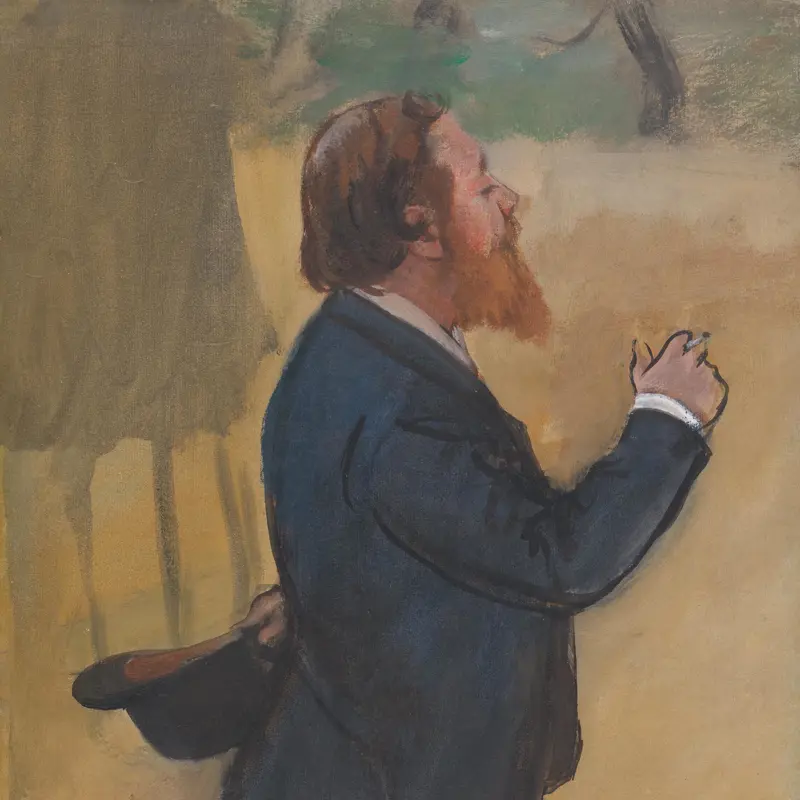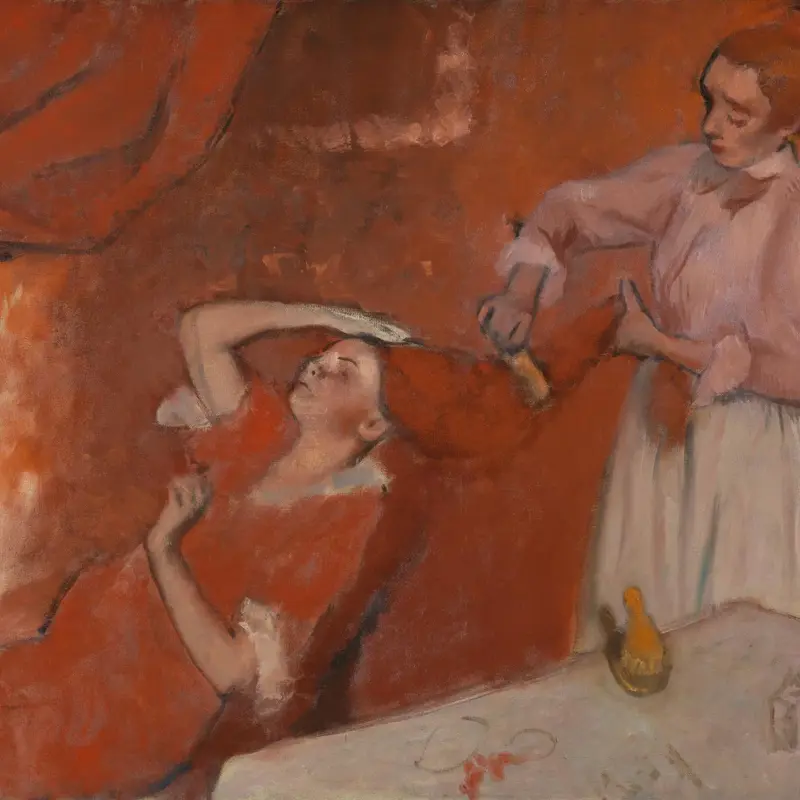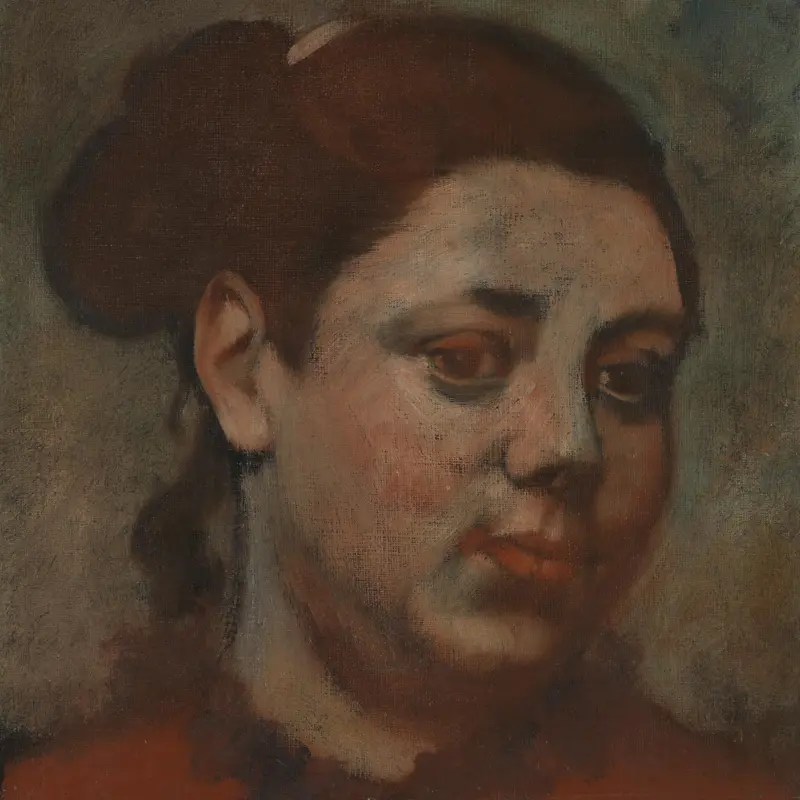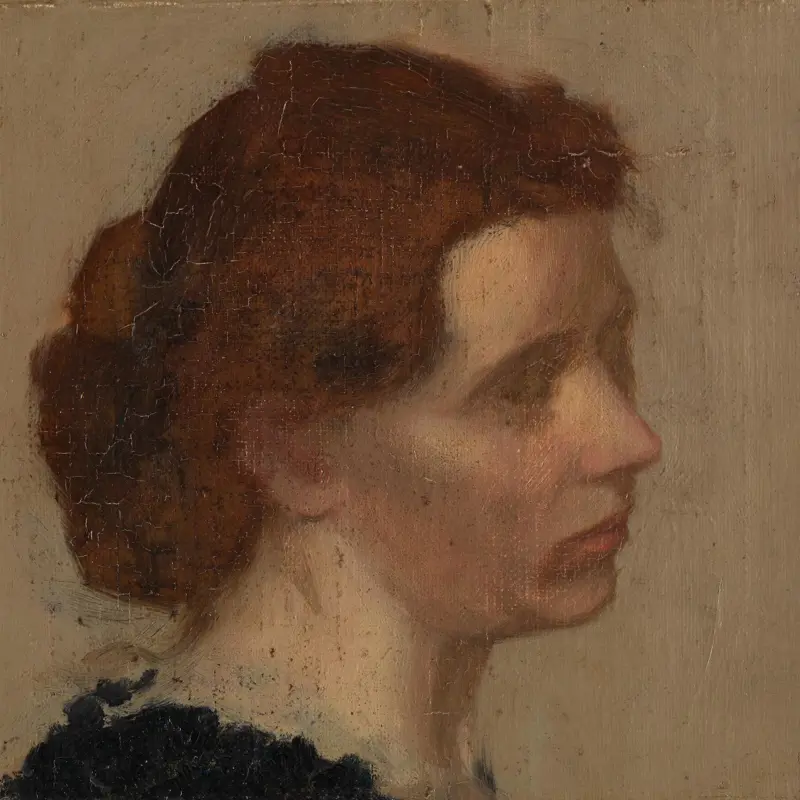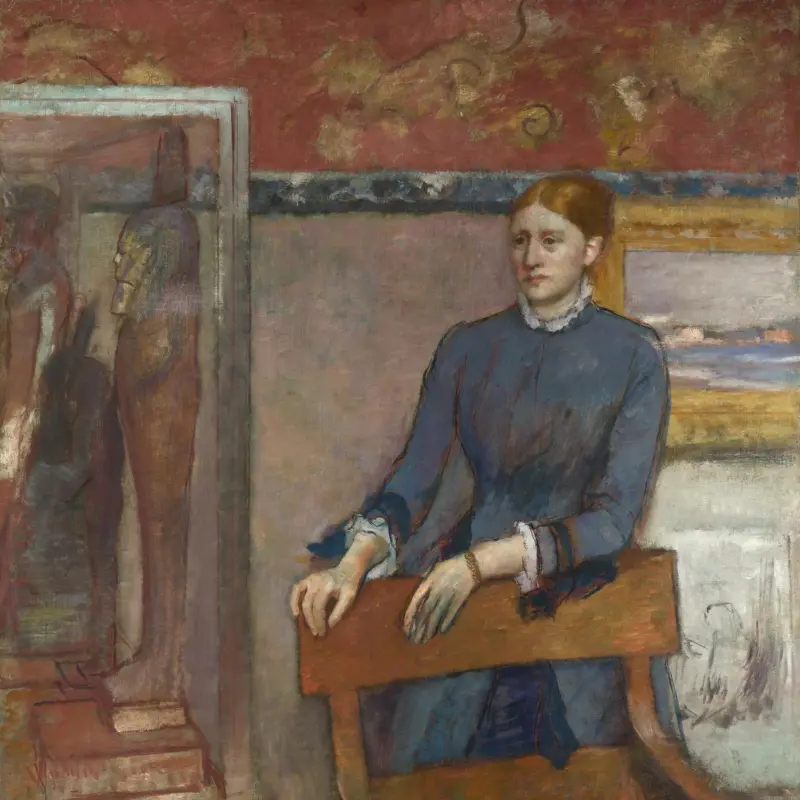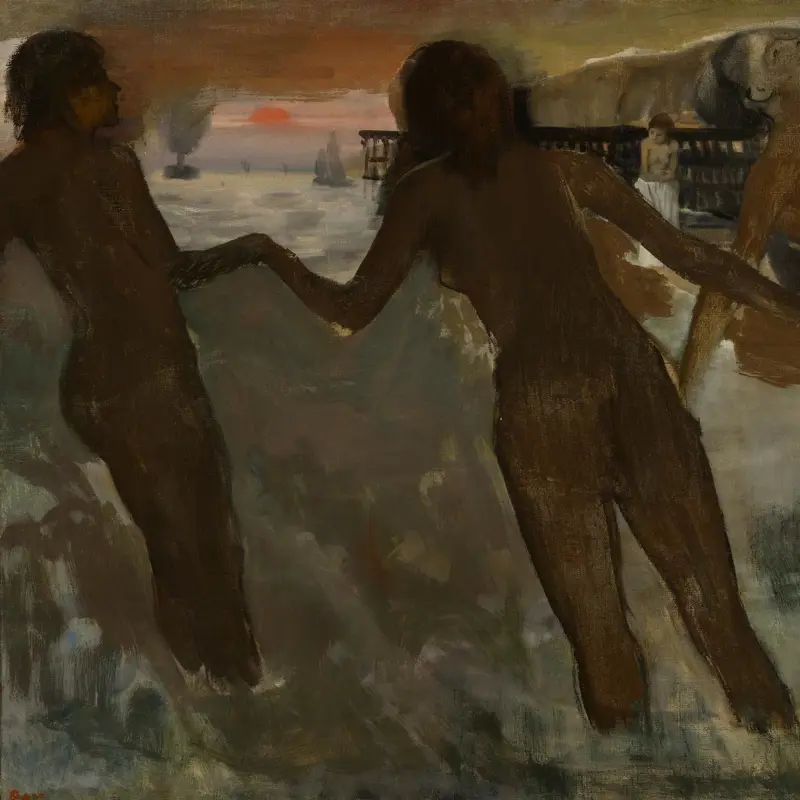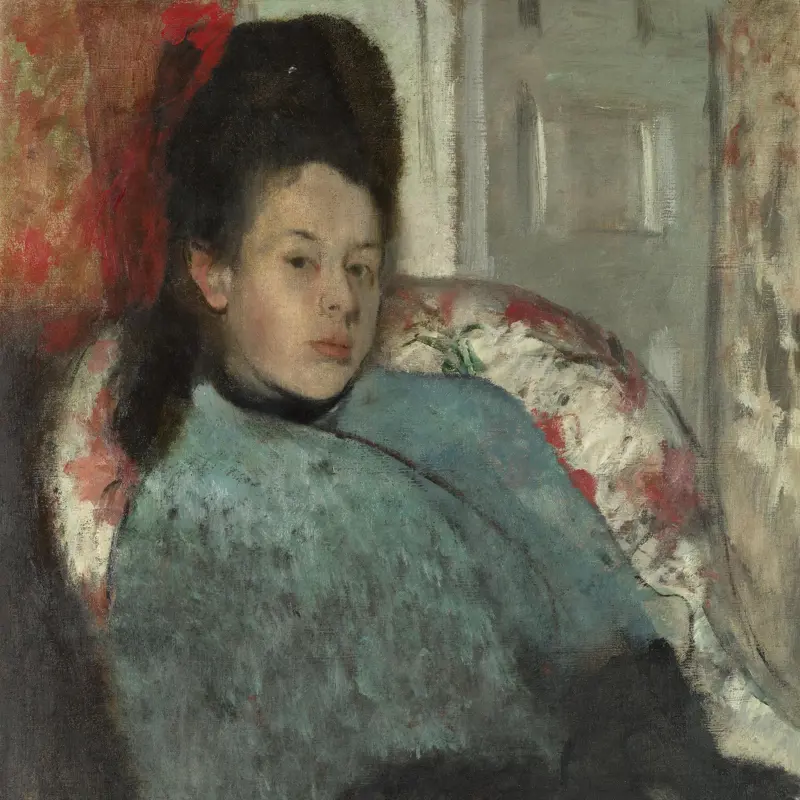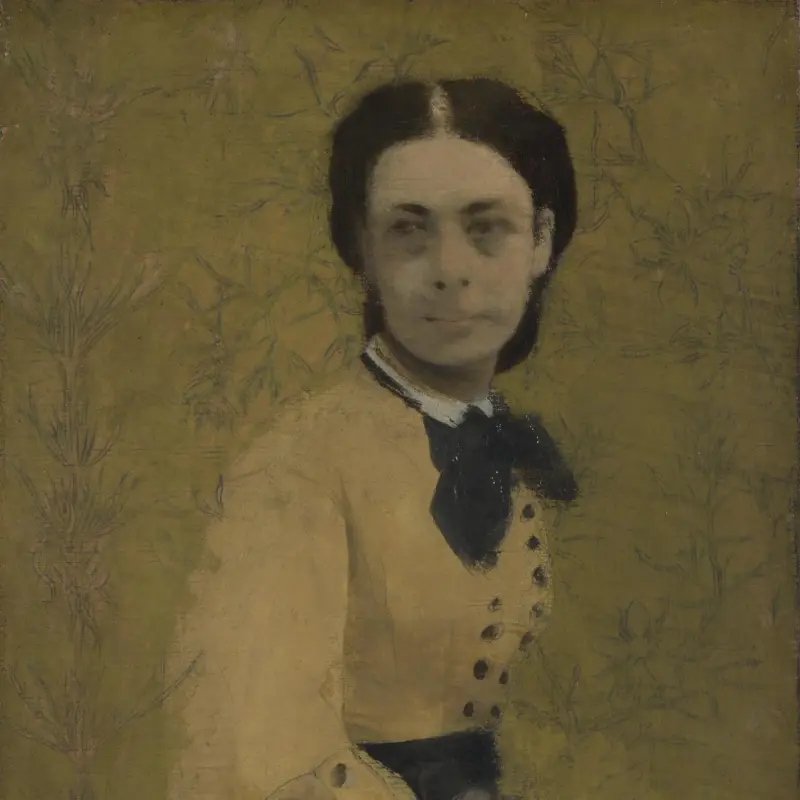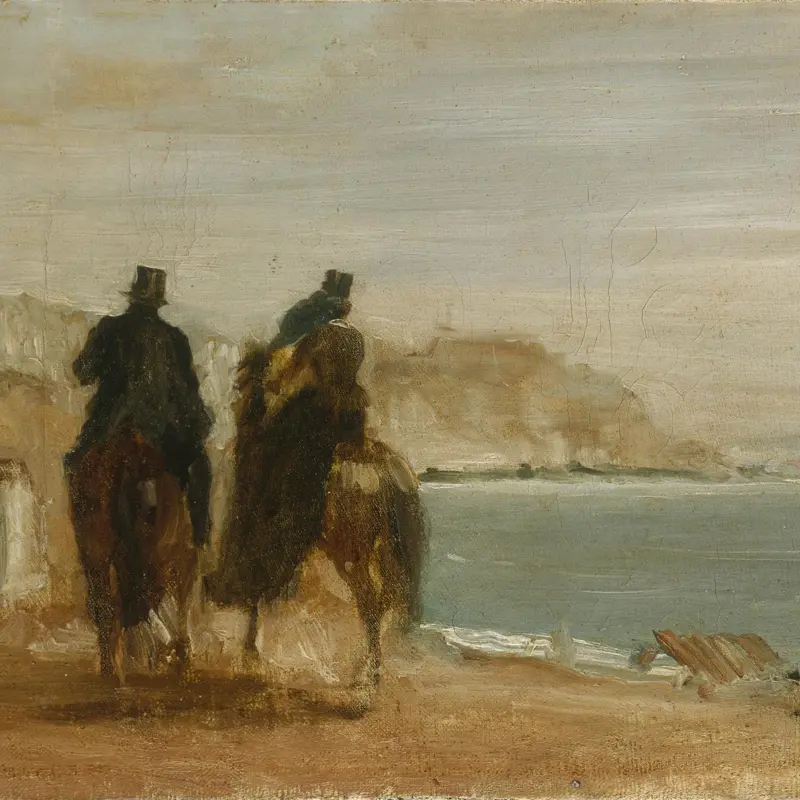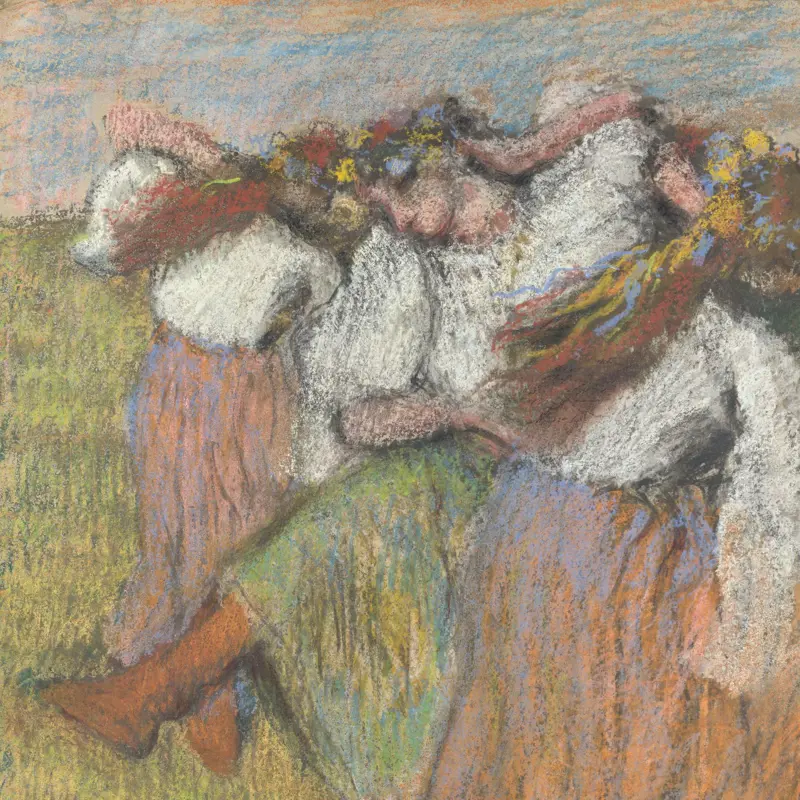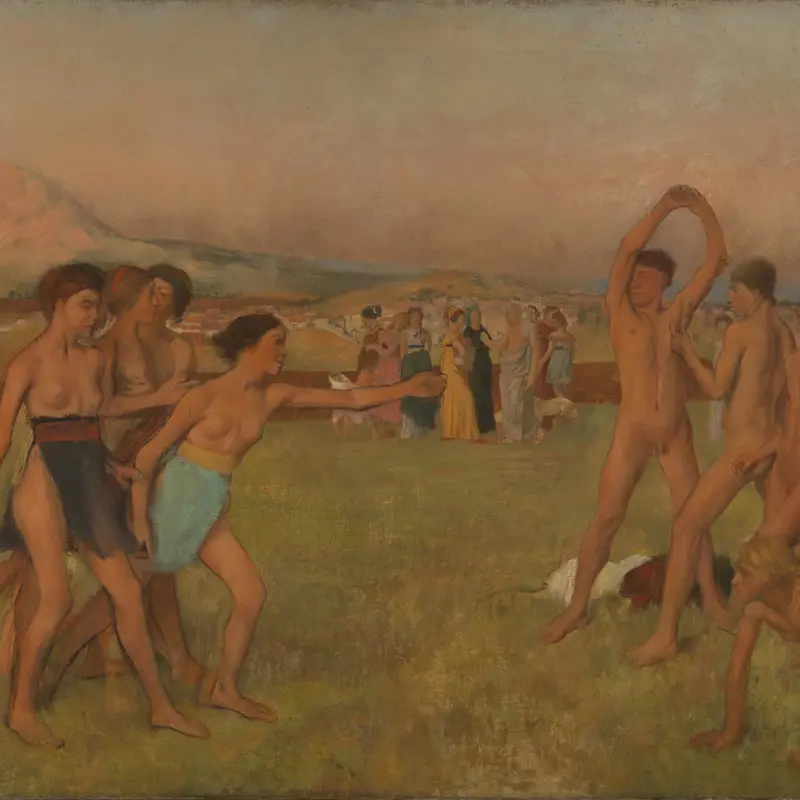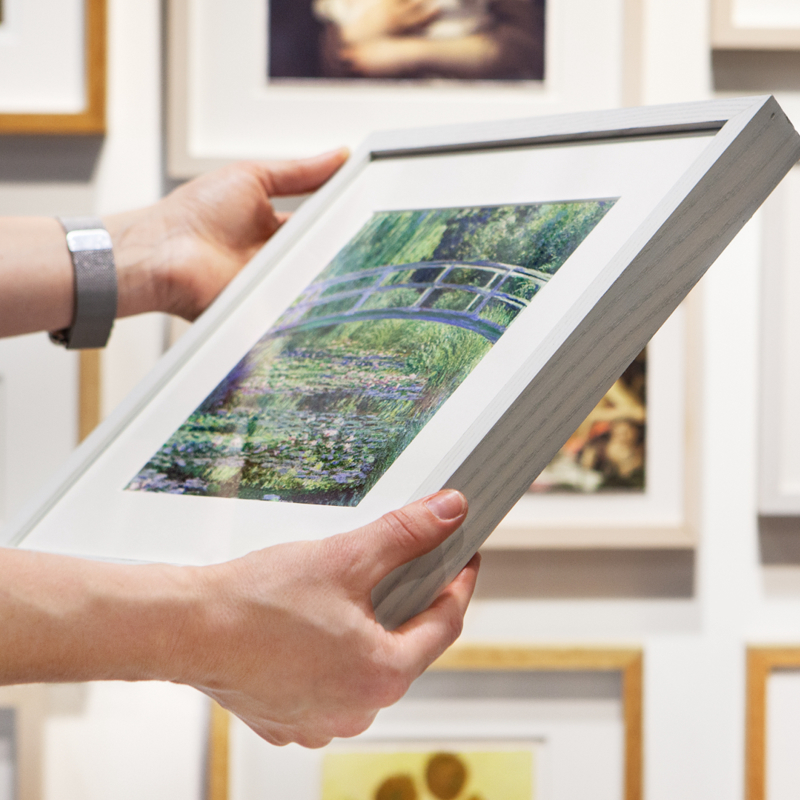Hilaire-Germain-Edgar Degas, 'Miss La La at the Cirque Fernando', 1879
About the work
Overview
The Cirque Fernando was built in 1875 near the Place Pigalle in Paris, close to where Degas lived. He saw Miss La La perform there several times. Born Anna Albertine Olga Brown (1858-1945), she was a mixed-race circus performer famous for her feats of strength. Olga is especially known as the inventor of the ‘Iron Jaw’ act, where she holds herself up by clenching a leather mouthpiece between her teeth.
In the painting, she is seen during one of her famous Iron Jaw performances. She is suspended from the ceiling as she is hoisted up to the roof by a rope. In one of her other acts she even carried a firing cannon, while dangling upside down from a trapeze. Degas places us among the audience, looking up at the spectacle above.
Painting an acrobat allowed Degas to combine his interest in modern life with his fascination for complicated poses. He made several preparatory studies for Miss La La’s portrait, paying particular attention to the complex construction of the roof, which covers most of the canvas. After it was finished, the painting was shown at the Fourth Impressionist Exhibition in Paris in 1879.
Key facts
Details
- Full title
- Miss La La at the Cirque Fernando
- Artist
- Hilaire-Germain-Edgar Degas
- Artist dates
- 1834 - 1917
- Date made
- 1879
- Medium and support
- Oil on canvas (unlined)
- Dimensions
- 117.2 × 77.5 cm
- Inscription summary
- Signed
- Acquisition credit
- Bought, Courtauld Fund, 1925
- Inventory number
- NG4121
- Location
- Room 43
- Collection
- Main Collection
- Frame
- 17th-century Italian Frame
Provenance
Additional information
Text extracted from the ‘Provenance’ section of the catalogue entry in Martin Davies, with additions and some revisions by Cecil Gould, ‘National Gallery Catalogues: French School: Early 19th Century, Impressionists, Post-Impressionists, etc.’, London 1970 and supplemented by Isobel Muir; for further information, see the full catalogue entry.
Exhibition history
-
2013Degas, Miss La La, and the Cirque FernandoThe Morgan Library & Museum15 February 2013 - 12 May 2013
-
2014Inventing Impressionism: Paul Durand-Ruel and the Modern Art MarketMusée du Luxembourg9 October 2014 - 8 February 2015The National Gallery (London)4 March 2015 - 31 May 2015Philadelphia Art Museum24 June 2015 - 13 September 2015
-
2018Circus! Show of ShowsWeston Park Museum21 July 2018 - 4 November 2018
-
2018Black Models from Géricault to MatisseMusée d'Orsay25 March 2019 - 21 July 2019
-
2024Impressionism and Its Overlooked WomenOrdrupgaard9 February 2024 - 19 May 2024
-
2024Discover Degas and Miss La LaThe National Gallery (London)6 June 2024 - 1 September 2024
Bibliography
-
1883J.K. Huysmans, L'Art moderne, Paris 1883
-
1939L. Venturi, Les archives de l'impressionnisme, Paris 1939
-
1943L. Browse (ed.), Sickert, London 1943
-
1946P.-A. Lemoisne, Degas et son oeuvre, Paris 1946
-
1952Barber Institute of Fine Arts, Catalogue of the Paintings, Drawings, and Miniatures in the Barber Institute of Fine Arts, Cambridge 1952
-
1954D. Cooper, The Courtauld Collection: A Catalogue and Introduction, London 1954
-
1955D. Cooper and M. Dreyfus-Bruh, Impressionistes de la Collection Courtauld de Londres, (exh. cat. Musée de l'Orangerie, October 1955 - January 1956), Paris 1955
-
1957Martin Davies, National Gallery Catalogues: French School, 2nd edn (revised), London 1957
-
1959R. Alley, Tate Gallery Catalogues: The Foreign Paintings, Drawings and Sculpture, London 1959
-
1970Davies, Martin, and Cecil Gould, National Gallery Catalogues: French School: Early 19th Century, Impressionists, Post-Impressionists etc., London 1970
-
1974J. Lassaigne and F. Minervino, Tout l'oeuvre peint de Degas, Paris 1974
-
1976T. Reff, The Notebooks of Edgar Degas. A Catalogue of the 38 Notebooks in the Bibliothèque Nationale and other Collections, Oxford 1976
-
1976T. Reff, Degas: The Artist's Mind, London 1976
-
1977J.W. Goodison, Fitzwilliam Museum, Cambridge: Catalogue of Paintings, vol. 3, British School, Cambridge 1977
-
1979I. Dunlop, Degas, London 1979
-
1979D. Sutton, 'Edgar Degas: Master of the Melodic Line', Apollo, 1979, pp. 166-75
-
1979R. Pickvance, Degas 1879. Paintings, Pastels, Drawings, Prints and Sculpture from around 100 Years Ago in the Context of his Earlier and Later Works (exh. cat. Scottish National Gallery, 13 August - 30 September 1979), Edinburgh 1979
-
1981E. de Keyser, Degas: Réalité et métaphore, Louvain 1981
-
1983R. Pickvance, Edgar Degas, 1834-1917 (exh. cat. David Carritt Ltd, 2 November - 9 December 1983), London 1983
-
1985M. Cormack, A Concise Catalogue of Paintings in the Yale Center of British Art, New Haven 1985
-
1985R. Thomson, 'Notes on Degas's Sense of Humour', in R. Kendall (ed.), Degas 1834-1984, Manchester 1985, pp. 9-18
-
1986D. Sutton, Edgar Degas: Life and Work, New York 1986
-
1986C.S. Moffett, The New Painting: Impressionism 1874-1886 (exh. cat. National Gallery of Art, Washington, 17 January - 6 April 1986; The Fine Arts Museums of San Francisco, M.H. de Young Memorial Museum, 19 April - 6 July 1986), Oxford 1986
-
1988C. Pencenat, '"Miss Lala au Cirque Fernando" de Degas', Magazine beaux-arts, 55, 1988
-
1990F. Milner, Degas, London 1990
-
1994S. Le Men, Seurat & Chéret: Le peintre, le cirque et l'affiche, Paris 1994
-
1995A. Distel, Gustave Caillebotte: Urban Impressionist (exh. cat. Galeries Nationales du Grand Palais, 16 September 1994 - 9 January 1995; Art Institute of Chicago, 18 February - 28 May 1995; Los Angeles County Museum of Art, 22 June - 10 September 1995), Paris 1995
-
1998J. Hargrove, 'Degas's Little 14-year-old Dancer: Madonna of the Third Republic?', Sculpture Journal, II, 1998, pp. 97-105
-
1999Sotheby's, Impressionist and Modern Art, Part II, New York, 12 May 1999
-
2001
C. Baker and T. Henry, The National Gallery: Complete Illustrated Catalogue, London 2001
-
2004Galeries nationales du Grand Palais, La grande parade: Portrait de l'artist en clown (exh. cat. Galeries Nationales du Grand Palais, 11 March - 31 May 2004; National Gallery of Canada, 25 June - 19 September 2004), Paris 2004
-
2005J. Marsh, Black Victorians. Black People in British Art 1800-1900 (exh. cat. Manchester City Art Gallery, 1 October 2005 - 6 January 2006; Birmingham Museum and Art Gallery, 28 January - 2 April 2006), Manchester 2005
-
2005P. Spencer-Longhurst, Reunited: Degas and Miss La La at the Cirque Fernando (exh. cat. The Barber Institute of Fine Arts, 17 February - 15May 2005), Birmingham 2005
-
2007M.R. Brown, 'Miss la la's Teeth: Reflections on Degas and Race', Art Bulletin, LXXXIX/4, 2007, pp. 738-65
About this record
If you know more about this work or have spotted an error, please contact us. Please note that exhibition histories are listed from 2009 onwards. Bibliographies may not be complete; more comprehensive information is available in the National Gallery Library.

